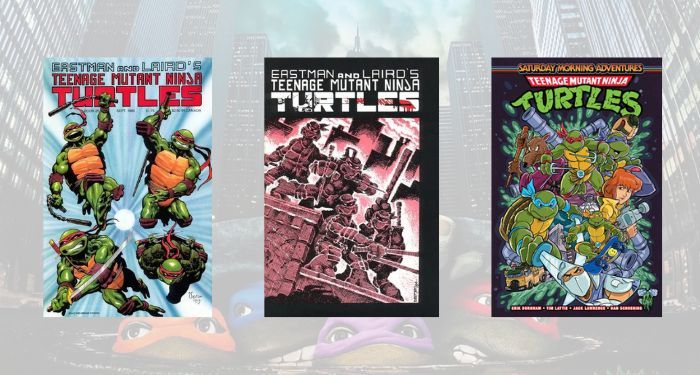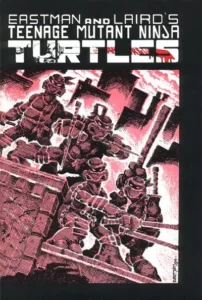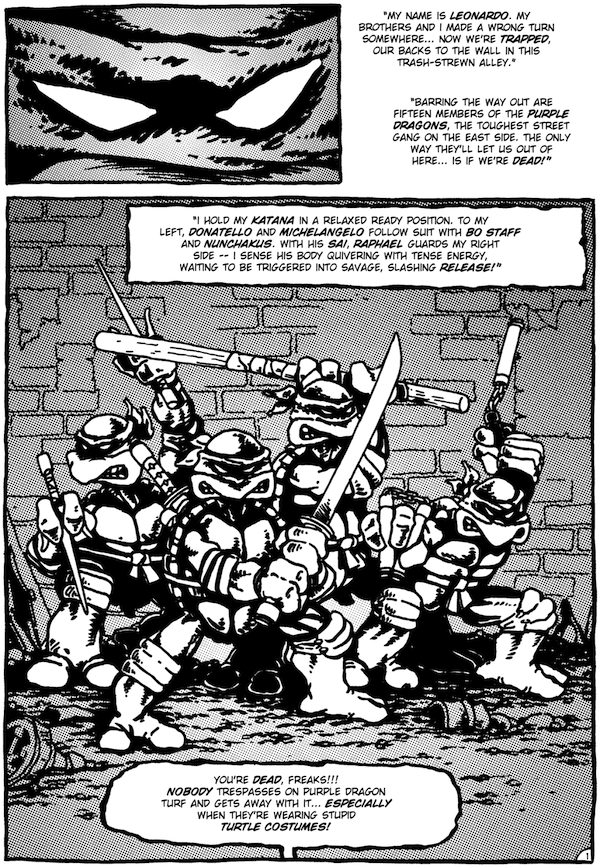
Cowabunga! A Look Back at 40 Years of Teenage Mutant Ninja Turtles
Forty years ago, in May of 1984, two young, unknown men sat at a table at a comic book convention in Portsmouth, New Hampshire. It was the first-ever Portsmouth Mini-Con, a tiny, local event with about 200 attendees. The two young creators had brought along their new comic, which they had published through their own independent publishing company, Mirage Studios, with an initial print run of 3,275 copies. It was printed in black and white on cheap newsprint, and copies sold for $1.50 each.
There was no reason to believe that this deliberately silly, cheaply produced comic would change comics and pop culture history or that one of those $1.50 copies would someday be worth thousands, if not tens of thousands, of dollars on the collectors’ market. But this was the debut outing of Teenage Mutant Ninja Turtles #1.

The Turtles were the brainchild of Kevin Eastman and Peter Laird. The year before, they’d been goofing around, and Eastman had drawn a turtle standing on its hind legs, wielding nunchucks. Laird added the words “teenage mutant.” They were riffing on the most popular comics of the era: the teens of DC’s The New Teen Titans, the mutants of Marvel’s Uncanny X-Men, and the ninjas of Marvel’s Daredevil. (The turtle part was the punchline, but it played into a strong comic tradition of funny animals.)
That first turtle was given three brothers, and the brothers were given the names of Italian Renaissance artists — Leonardo, Donatello, Raphael, and Michelangelo (as if you didn’t already know that) — as a bit of added silliness. The creators drew a comic, emptied their bank accounts and borrowed money to print it, ran a full-page ad in Comic Buyer’s Guide to get retailers’ attention, and set up their table in Portsmouth.
The gamble worked. Within weeks, they sold out and had to reprint. Demand was so high that they decided to turn their one-shot into a series. Teenage Mutant Ninja Turtles #2 had 15,000 preorders. Issue #3 had 50,000 preorders. Cowabunga!
If you’re around my age — I am one month older than the Turtles — you don’t need to be told about the total world domination (turtle world domination?) that stemmed from that little comic that could. As a kid, I knew the Turtles as a glitzy corporate franchise, with a long-running cartoon, live-action movies, video games, action figures, Hostess Teenage Mutant Ninja Turtle Pies (they were green!), and a live show at Radio City Music Hall. But for this anniversary, I thought I’d dive into TMNT #1 and see where Turtlemania all began.

That “where” is a dark alley, with the Turtles taking on 15 members of a street gang as their first outing as ninjas. They efficiently demolish the gang, then return to the sewers where their sensei and adoptive father, the rat Splinter, welcomes them. He then embarks on a lengthy eight pages of exposition of how he came to be a giant rat who knows ninjitsu (short version: ninja love triangle) and the Turtles’ own origin. (There’s a not-so-subtle reference to the Daredevil inspiration as Eastman and Laird show that the same radioactive ooze that blinded young Matt Murdock and heightened his other senses also mutated the then-infant turtles. So yes, technically, there’s an unauthorized Daredevil cameo in this book. The other DD reference: the evil Foot Clan the TMNT fight is a parody of Marvel’s Hand ninjas.)
Splinter sends Raphael to deliver a challenge to the evil ninja, the Shredder, who killed his former owner years ago as part of the aforementioned ninja love triangle. Shredder accepts, and there’s an 11-page fight scene between the Turtles and Shredder and the Foot Clan. At the end, Shredder falls to his death…or does he?
If you’re expecting the pizza-twirling silliness of the ’80s cartoon or even the cuddliness of the Jim Henson-created Turtles of the 1990 movie — the highest-grossing independent film of all time when it released! — the original comic is jarring. The art is engaging but relatively crude, with a slapdash, (accurately) homemade feel. Though they have their characteristic weapons (Leonardo’s katana, Raphael’s sai, Donatello’s bo staff, and Michelangelo’s nunchucks), the Turtles are missing their color-coded bandanas because the comic is in black and white, and they have almost nothing in the way of distinct personalities except for a slight restlessness and extra relish for violence from Raphael.
More startlingly, there is one joke, and it’s the premise. The humor comes entirely from an uber-violent tale of ninjas and revenge being told with deadly seriousness about…turtles. The unrelentingly grim Turtles kill their enemies without pity or regret and, at one point, demand that Shredder commit seppuku. (Remember, the ’80s were the decade of grim ‘n’ gritty, comics-aren’t-just-for-kids-anymore boundary-pushing.) It’s incongruous enough to be funny at first, but the shock value of the joke wears off pretty quickly, and there’s barely enough story left over to fill the 40 pages Eastman and Laird gave themselves.
In other words, there isn’t much to indicate that this book would become a sensation. But it did. Though the comics were successful, Turtlemania was really thanks to the 1987 cartoon, which ran for nearly a decade and significantly softened the Turtles for a child audience, making them much broader comedic characters and taking out all the, um, murder. Eastman and Laird have both expressed regret over the changes the show made, which…did you forget this was supposed to be a joke to begin with, guys?
From there, the Turtles went on to star in four more cartoons, seven theatrical feature films, a live-action TV show, and more. I don’t have the space for an exhaustive rundown of their career, but here are a few highlights:
- Actors who have appeared in Turtle movies and shows include: Corey Feldman, Sam Rockwell, Skeet Ulrich, Chris Evans, Sarah Michelle Gellar, Kevin Smith, Patrick Stewart, Ziyi Zhang, Laurence Fishburne, Jason Biggs, Seth Green, Sean Astin, Mae Whitman, Megan Fox, Will Arnett, Whoopi Goldberg, Tony Shalhoub, Laura Linney, Tyler Perry, Ben Schwartz, John Cena, Chelsea Peretti, Johnny Rotten, Lena Headey, Ayo Edebiri, Maya Rudolph, Seth Rogen, Rose Byrne, Jackie Chan, Ice Cube, and Paul Rudd. Okay!
- In 1990, Pizza Hut sponsored a live musical called Coming Out of Their Shells, which starred the Turtles as a rock band. It kicked off at Radio City Music Hall before embarking on a 40-show tour, plus an appearance on Oprah.
- I feel like it’s obligatory to mention Venus de Milo, the sister turtle introduced in the live-action TV show The Next Mutation, who was pretty universally reviled. And, well. I’m always in favor of more female characters, but this one was, uh…underthought. (She had turtle boobs.)
- On a sadder note, early ’90s Turtlemania led to the importation of about 250,000 red-eared sliders into the UK for kids who wanted them as pets, not knowing that they can a) grow to the size of a dinner plate and b) live for 30 years. Many of those turtles were abandoned in streams and ponds, devastating local ecosystems and leading to them being banned by the EU. As someone who has had a red-eared slider for 22 years, I take this one pretty personally.
If all this has gotten you craving some heroes on the half shell, last year’s animated theatrical film Teenage Mutant Ninja Turtles: Mutant Mayhem was critically acclaimed, and a sequel series, Tales of the Teenage Mutant Ninja Turtles, is set to premiere this summer. If you want to go back to the Turtles’ comics roots, IDW currently holds the TMNT license. The most recent volume (and longest-running Turtles comic ever) just ended with #150, but IDW plans to launch a new volume in July, written by Jason Aaron and drawn by a quartet of superstar artists (Joëlle Jones, Rafael Albuquerque, Cliff Chiang, and Chris Burnham).
Finally, I leave you with perhaps American pop culture’s greatest artistic achievement: the “Ninja Rap” scene from 1991’s Teenage Mutant Ninja Turtles 2: Secret of the Ooze, featuring Vanilla Ice:
Happy birthday, boys. Go ninja, go ninja, go, indeed.








